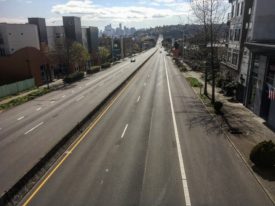An analysis by Sightline Institute of new US Census data indicates that the Northwest’s economic security, which has been on the wane since 1990, continues to stagnate. From 1990-1992 to 2000-2002*, poverty rose slightly in the region from 10.9 to 11.1 percent, even while the nation’s poverty rate sunk to 20-year lows. Median income increased less than the national average, and the region’s unemployment rate surpassed the national average.
“Washington and Oregon were once ahead of the nation in economic security,” says Eric de Place, a research associate with Seattle-based research center Sightline Institute (formerly Northwest Environment Watch). “But the new figures confirm that our leadership has all but vanished.” De Place is lead author of the June 2003 report “Falling Behind: The Economic Security of Northwest Families Since 1990.”
“Falling Behind” examines more than a decade’s worth of data on poverty, unemployment, and income for the Pacific Northwest states—Idaho, Washington, and Oregon—and compares regional figures with national trends. Key findings, updated in this backgrounder with 2002 figures, include:
- Growing economic output and poverty: From 1990 to 2001, a period in which the Northwest was regarded as an epicenter of opportunity, inflation-adjusted gross state product rose by 63 percent. But the Northwest also lost its historic lead in economic security, and 2002 figures show that it’s not rebounding. The region’s poverty rate rose from 10.9 percent to 11.1 percent from 1990-1992 to 2000-2002. During the same period, the national poverty rate fell from 14.2 to 11.4 percent.
- Median income stagnating: From 1990-1992 to 2000-2002, the Northwest’s median income—the income that half of all households exceed and half fall below—rose by 7 percent, or about $2,900. In the same period, the nation’s median income shot up 12 percent, or about $4,600.
- Washington and Oregon slipping; Idaho gaining: The regional story masks differences in state trends, particularly for Idaho, which still lags the region in some measures but made improvements over the decade. From 1990-1992 to 2000-2002, Idaho posted a decline in the poverty rate (from 14.7 percent to 11.8 percent) and a 15 percent increase in median income. Washington began the 1990s with advantages in poverty rates, unemployment rates, and median incomes, but by 2002, much of this lead had vanished, with a poverty rate that rose from 9.9 to 10.8 percent. Oregon experienced a significant increase in unemployment, but a slight dip in poverty rate and a median income trend that paralleled the nation’s increase.
- Rising unemployment since mid-1990s: Although the Northwest began the decade with unemployment rates near the national average, beginning in 1995 Northwest unemployment inched above the national rate, where it has stayed ever since. In recent years, Washington and Oregon have had some of the highest unemployment rates in the nation, topping 7 percent in 2002, compared to a national rate of 5.8 percent.
- Widening income gap: (No 2002 figures available.) The Northwest’s per capita personal income grew by about 20 percent from 1990 to 2001, a boom-time rate of growth. But most of the gains went to the highest-earning fifth of households, who earned 30 percent more annual income in 2001 than in 1990—an added $31,000, enough to buy a new full-sized SUV each year. The income of the middle class (the middle fifth) grew by 6 percent, or $2,500 (compared to $3,500 nationally), and the lowest-earning fifth of households earned slightly less in 2001 than in 1990. In other words, for every new dollar earned by the middle class in the Northwest, the wealthy earned $13 more, and low-income households made a few pennies less.
“Falling Behind” notes that the reasons for the Northwest’s poor record in economic security since 1990 are not clear, particularly because the trends began well before the recent economic downturn. But it suggests that by judging the recent “boom” as an economic success based on only a few measures, the Northwest failed to detect an equally important story: increasing numbers of poor families and meager economic gains for the majority of northwesterners.
“The economic boom of the 1990s was hollow for many people,” says de Place. “Because we weren’t paying attention to the right indicators, we missed the warning signs.”
Tracking economic security is important for a host of reasons, the report says. Extensive study shows that economic hardship, particularly long-term poverty, is linked to social ills ranging from school failure to crime, and from teen births to child abuse. Economic hardship also increases pressure on public resources.
Sightline Institute (formerly Northwest Environment Watch), a Seattle-based nonprofit research and communication center, is developing a regional index that tracks key trends of people, place, and the future of both. The index—which will be launched in 2004—will include economic security. See http://scorecard.sightline.org for more details.
– US Census data on income and poverty can be found at: http://www.census.gov
*Note: All figures for poverty and income refer to three-year rolling averages, which is why our numbers sometimes differ from other reported rates (single-year rates are often reported).






